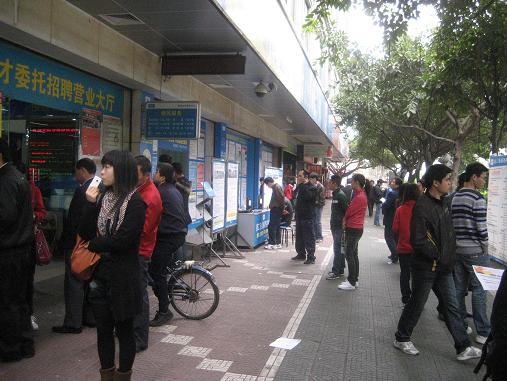Business as usual in Guangdong’s factories after the New Year Holiday [1]
19 March 2015Nearly 95 percent of Guangdong’s roughly ten million migrant workers have returned to the province after the Spring Festival break, the provincial human resources and social security bureau announced yesterday.
A total of 9.67 million migrant workers had returned by 15 March [2], about the same level as last year, and employee numbers in 80 percent of Guangdong’s enterprises had already reached or exceeded pre-holiday levels.
The bureau spokesman stressed that despite the economic downturn and decline of manufacturing, the labour market in the province was basically balanced with about 400,000 more jobs available than the number of people looking for work. The overall ratio of jobs available to job seekers was now 1.09, the spokesman said.

Job seekers at a recruitment centre in Dongguan
The spokesmen did however concede that many smaller enterprises were in difficulty and that there was a serious mismatch between the jobs employers need to fill and the jobs employees want to do.
Worker discontent over wage arrears, low wages and social security quickly returned to pre-holiday levels as well. CLB’s Strike Map [3] has already recorded 20 strikes and worker protests in the province in the three weeks since the end of the New Year holiday.
Several strikes involved more than a thousand workers, including those at the Yue Yuen [4] and Stella [5] shoe factories in Dongguan, and a Hong Kong-owned eyewear manufacturer [6] in Shenzhen where 5,000 workers went out on strike on 16 March.
The long awaited increase in the minimum wage in Guangdong [7], which will go into effect on 1 May this year, might help to reduce some tension in the workplace. However, employers in low cost industries very often respond to increases in the minimum wage by cutting back on employee benefits in other areas, and this frequently gives rise to strikes and protests. Demands for payment of social insurance and housing funds are likely to continue as well, as the workforce ages and manufacturing industries restructure.
